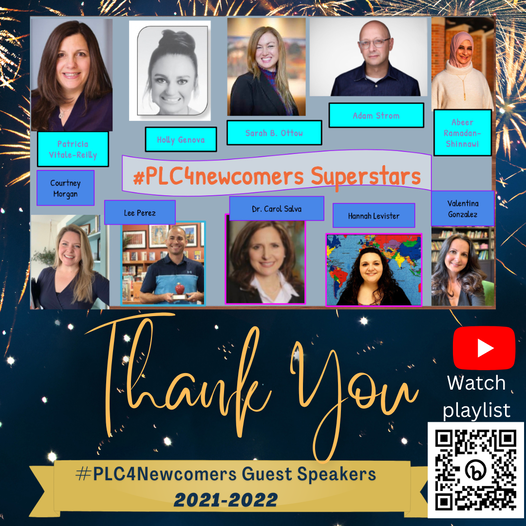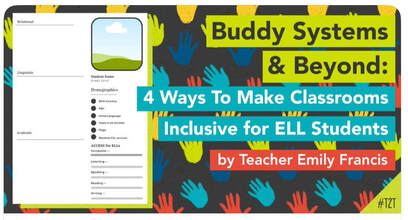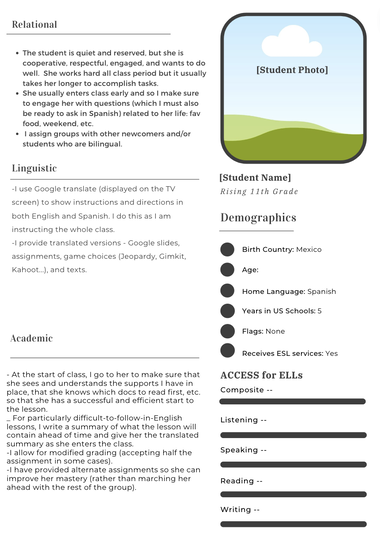|
What a year!! In October 2021, I started meeting virtually with a group of teachers of newcomers who are interested in learning new strategies, and gain lessons ideas to serve and teach their newcomers. I have a list of over 300 teachers who monthly receive an invitation to meet and learn together. Of course, not all teacher attend, but sessions are recorded and I know MANY go back and catch up on the recording.
Our monthly meeting routine is basically the same every time. We have an expert and guest speaker share for 30-40 minutes then we go into grade-level breakout rooms to discuss deeper about the topic. In our breakout room, we have a shared document where we make notes of any ideas or resources we lean about from each other. I am so grateful to amazing and superheroes in the field who have agreed to join us and share their expertise with us. We are better because of their teaching and guidance. A HUGE shoutout to these amazing #PLC4newcomers’ superstars who shared with us from November 2021 to December 2022. If you are interested in watching our previous meetings, follow this link to my YouTube channel ===> https://bit.ly/PLCplaylist We are continuing these meetings in 2023. If you'd like to joining our PLC email list, please enter your information HERE and I will make sure you're invited to our next meetings. Be sure to check out these amazing presentations and follow our SUPERSTARS!!
November - Supporting Struggling Learners with Patricia Vitale-Reilly -- @pattyvreilly
December - Does This Work with English Learners? Holly Genova -- @GenovaHollyAnn January - Language Lens with Sarah B. Ottow -- @SarahOttow March - Re-Imagining Migration with Adam Strom -- @afstrom March/April -- Ramadan with Abeer Ramadan-Shinnawi - @shinram1 May - Wild About WIDA with Courtney Morgan -- @MrsMorganTeach June - Celebrating Us with Lee Perez - @LanguagePerez October 2022 -- Boosting Achievement with Carol Salva -- @DrCarolSalva November 2022 - Engaging Families with Hannah Levister -- @HannahL_MLP December 2022 - Sense of Belonging with Valentina Gonzalez -- @ValentinaESL
If you watch any of these fantastic presentations and find it helpful, please share a comment with me. I'd love to know how we're impacting YOU and your students.
Thank you for reading and watching!
0 Comments
This post first appeared on Teacher2Teacher website on November 30th, 2022 HERE Buddy Systems & Beyond: 4 Ways To Make Classrooms Inclusive for ELL StudentsAs a longtime ELL teacher and inclusion co-teacher I work alongside content-area teachers to develop more welcoming experiences for our ELL students. I traveled to the United States as a child with my family from Guatemala. Having lived the experience of learning English as a student, I have an instant understanding of what my ELL students are experiencing. But I know that many teachers don’t share that background. It can be a new way of thinking for teachers: What does a student who is learning English need in order to be successful in a general education setting? What does a student need to feel truly included in our learning communities? Every teacher I know wants their classroom to feel comfortable and supportive for students. Here are 4 ways my teacher colleagues and I build those communities. 4 Ways To Include ELL Students in Your Learning Community1. Create student learning profiles to communicate strengths and needs across teacher teams. Last year, our team of ELL teachers collaborated with general education teachers to create student profiles that would be passed on to the next year’s teaching team. Our thinking was that after spending a full school year learning about the strengths and needs of our students, we’d gathered valuable information that could benefit those students moving forward. We pulled some of the information stored in our school systems about each student, we added a photo and then described our students’ academic strengths and needs along with accommodations that each student found supportive. We shared what we knew about the students’ English speaking and listening skills, and which tools, like Google Translate, they used to help them. At the beginning of the school year, we shared links to the profiles so teachers could glance at the photos and pick up some information even as they were still learning students’ names. Teachers would say, “Oh, I didn’t know Ani uses Google translate.” The student data stored in our school system is full of numbers and information that can be a lot for a teacher to absorb about every new student. These profiles distilled the essential information, going beyond official records to highlight approaches recommended by one teacher to another. It cut down the ramp-up time at the beginning of the year, so students and teachers could hit the ground running. 2. Build trust and develop “buddy systems.” In language-inclusion classrooms, our ELL students have the chance to learn alongside their peers and practice their English skills. One of the accommodations that can be required for immigrant students is to have a classroom buddy, and this works best when a sense of shared responsibility for one another’s learning is built in the classroom. Buddy systems can be so valuable, because we want our ELLs to work using the English language, but if they don’t have trust with the person you pair them with, then there’s going to be no communication at all. Teachers should develop a list of students who can share the responsibility students share as learners. To identify potential buddies, teachers can create a Google form where students can express the level of support they are willing to share with peers. Maybe one would like to show the student around the building, maybe another student would like to go over class procedures, or another student could go over classwork and homework requirements. Students will feel more comfortable when all this important information comes from peers who are learning just like they are. As teachers, our job isn’t just to help our ELL students, but to build a community in which students support each other. 3. Try to shift perspective to understand students’ behavior. The majority of the teachers who were born here have totally different lived experiences than our students, and that can lead to misunderstandings. So much of being an effective teacher for ELL students comes down to the empathy to imagine what it’s like to walk in a student’s shoes. For example, a content teacher recently said that two of the ELL students in her class were “copying” each other’s work. I talked with her about how, from her perspective, “copying” an assignment is wrong, but I encouraged her to look at it from the students’ perspective. I said, “They don’t know English, and they’re trying to participate and meet your expectations. So, helping each other is actually collaboration, because they want to do the work and be active members of the classroom community.” The teacher immediately understood, and she began to reinterpret the moment from the students’ point of view. It was a moment of growth. As teachers, we may not always have the opportunity to learn about every student’s full experience. But we can take the time to learn about immigrant experiences through reading books and having conversations. We can try to imagine: What would I do if I were sitting in a classroom where I didn’t understand the language, but I wanted to engage? That type of thinking can inspire small changes that support our students. 4. Tap into your resources for your own growth, and be willing to be vulnerable. Now that I’ve moved into a full-time co-teaching role, I’m so impressed when teachers come to me with questions like, “Can you help me? I don’t have experience with ELL students. I don’t know how to approach this.” That’s being honest. I’m so grateful when teachers are willing to be vulnerable. Many schools and districts have resources available for teachers who want to grow in their ELL skill set, from ELL coaches and co-teachers like me to robust information-sharing systems. Many states and districts are also forming Teacher Networks where teachers of Multilingual learners or experts in language acquisition are gathering information and sharing resource hubs such as shared documents, websites with tools, book studies, and Twitter chats for learning. Some districts use the ELLevation platform. Not only does it house our ELL data, but it also provides a strategic component, where teachers can acquire activities to make content accessible and have more ELLs engaged in content and language learning. It can be hard to admit that something is beyond our expertise, but it’s so powerful. Coaches like me can do a lot more to support a teacher who is asking for help from that space of vulnerability. And I can return vulnerability in exchange, knowing that I may not know about math content, but I can offer strategies for sharing that content with our students. And isn’t that vulnerability what we ask of our students every day? Thank you for reading! |
Categories
All
Archives
May 2024
|


